Buenos Aires – Plaza de Mayo Axis

Casa Rosada: The Pink equivalent to the American White House
Visited November 26, 2005 Although today still recovering from the most significant economic crisis not caused by war or natural disaster, Argentina was once among the wealthiest nations of the world – around 1900 plus and minus a couple of decades. During that time, Buenos Aires took advantage of that wealth to plan two major axes rivaling the grand axes of Paris. These two were the Avenue 9 Julio described in another blog and its perpendicular: the Plazo de Mayo – Congress Axis down Avenida de Mayo. It takes vision or chutzpah (in Texas, we call it walking) to propose and execute such a grand design on an already functioning city. BA brought it off well! We saw the Plaza de Mayo twice, the first with our tour and later on a long walk to San Telmo which we’ll describe in another blog. Site of many turbulent events in Argentine history, this landscaped rectangle was calm and sparsely populated during our visits, except for some pigeons (maybe looking for a coup?) This square memorializes the 25 May 1810 ouster of the Spanish Viceroy and establishment of Buenos Aires provincial government. (Joseph Napoleon – you know who’s brother -- had taken the place of the king of Spain two years before so the provincials thought their mother country would be too distracted to fight back. A year later, the Pirámide de Mayo (pictured below) was erected; Liberty’s statue capped the pyramid later. Liberty holds a sword to remind the Argentines that they will have to fight for their freedom, mostly against their own Named after that revolutionary month, Plaza de Mayo is the site of frequent demonstrations. Even with Argentina’s return to democracy, every Thursday afternoon (since 1977), the Mothers of the Plaza de Mayo march to protest their children who “disappeared” (the desaparecidos) during the Dirty War (1976-1983) waged by the latest iteration of military junta against its own citizens. The mothers’ (and grandmothers’) white scarves bear the names of their missing offspring and are meant to symbolize diapers. (In a perverse Solomon-like twist, DNA tests now show that some desaparecido babies have emerged as adopted children of supporters of the regime.) Some of the other interesting events of the past include the 1945 demonstration that freed soon-to-be-strongman Peron from jail (and put him on the path to electoral victory) and the plaza bombardment ten years later by the country’s own air force. As recently as December 2001, bloody clashes forced the resignation – and helicopter departure -- of President de la Rua. These were tough times: in January 2002, the peso unhooked from the US dollar and quickly devalued to about 1/4 of its value (but made Argentina highly attractive to foreign tourists such as ourselves.) The poverty rate rose to 59%. But Argentina seems to be on its way back: Presently (2005) both inflation and unemployment are running at 12% , the poverty rate is down to pre-crisis levels at 38%-- but GDP, fueled by exports, is growing at 9%. Plaza de Mayo has been at the center of Buenos Aires (and later Argentine) government since its establishment in 1580. It was not always at the center of Buenos Aires, however. Originally the port was directly behind the square, but subsequent landfills have pushed the silver-brown Rio del la Plata further to the east. Let’s take a walk around the square starting with the presidential palace. The Casa Rosada (Pink House) anchors the plaza to the east on the site of a military fort during colonial days. The Argentine president now works here but lives elsewhere. The photo at the top of the page shows the left balcony where Eva Peron lectured her devoted followers, (and Madonna mimicked her in the film Evita). The balcony also witnessed the declaration of the ill-fated 1982 Malvinas/Falkland war which brought down the junta that started it, greatly pleasing the Mothers of the Plaza and a lot of other Argentines. The neo-Italian Casa Rosada dates from 1894. Supposedly it is pink to reconcile two warring Argentine factions who were represented by red and white colors. (Should Americans paint the White House purple?) It is guarded by the Granaderos a Caballo regiment in the same uniforms they used in 1813. Here’s a bleached photo of the changing of the Granaderos at the Pink Palace: Excuse the quality of this picture; a fence keeps photographers and others from getting too close to the Pink Palace. Trekking counter-clockwise around the square, we see the National Bank of Argentina, a massive building containing a numismatic museum. The bank played a role in the events on the square. For instance, starting in 1991 when the Argentine peso was pegged 1:1 with the US dollar, it had to hold as many dollars as pesos in circulation since Argentines could present pesos and demand an even dollar exchange. After 1998 as the economy deteriorated, Argentines converted pesos to dollars which they sent out of the country, causing a bank run in 2001. The government then froze accounts causing the citizens to take to the streets in demonstrations with pots and pans called Cacerolazo – the Spanish name for stewpots. These escalated into violent attacks on banks. The picture below is more typical of the square, which is landscaped as a park. The cathedral (our next destination) is at the right with the North Diagonal Avenue in the center. On the left is and edge of the new (at least compared to the cabildo which it replaced) city executive building built in 1902 in the belle époque style: Next to the banks is the Metropolitan Cathedral which lies at the Northwest edge of the Plaza de Mayo at Rivadavia Avenue, supposedly the longest avenue in the world. (With the 9 Julio Avenue being the widest in the world, you would think Argentines could give Texans a run for bragging rights). This 1745 church replaced the 1585 chapel, but its Greek-revival facade was added in 1829, giving the cathedra a most secular look: Here’s a close-up of the Cathedral’s pediment which shows the Old Testament story of Jacob meeting his successful son Joseph whom his siblings have sold into slavery in Egypt. Here’s a view of the cathedral cupola; we’ll look underneath it in the picture after next: Inside, the church is a military shrine: Draped in his country’s flag, the remains of the Argentine George Washington --General Jose de San Martin -- (or is our San Martin George Washington?) lay under the cupola photographed above: And finally the view from the nave and a closer-up of the main altar:
On any given Thursday: Decorated for the next demonstration
The Pink House

Changing of the Guard (but not the junta) at the Pink Palace
For want of a chicken in every pot


A placid Plaza de Mayo
The Cathedral

The 1829 façade of the Metropolitan Cathedral

A coat of a single color in this picture

Cathedral exterior
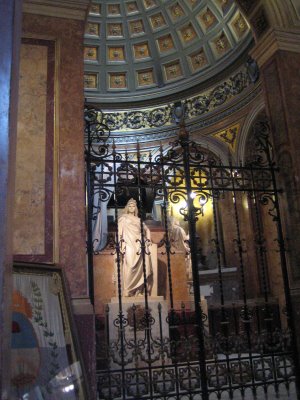
Tomb of San Martin
Here’s a close-up of the statue in front of his tomb with a listing of his famous battles for independence:
Look closely and you'll see his resume in marble

The Metropolitan Cathedral from the nave...

...and the Sanctuary
Plaza de Mayo is intersected by two diagonal avenues, this one is Diagonal Norte which leads to the Obelisk and the Plaza Lavalle discussed in another section of this travelblog.
Looking down Diagonal Norte to the obelisk
The next building in our counter-clockwise progression is the cabildo (town hall) -- or at least a remnant of it. The original 1751 building had five arches on either side instead of the two shown. (the Diagonal Norte and the Avenue de Mayo leading to the house of Congress ate the other arches on each side). The only colonial building on the square, the Cabildo was restored in 1939; it is now a museum of colonial history with an arts fair on its back patio. To the left (west) of the legislative building is the second diagonal, Diagonal Sur (South) also called Avenue Roca after their general/flag designer we discussed in the Bariloche blog. Roca’s extermination of the indigenous people had much to do with making BA the most European city in South America (with an assist for significant Italian and Spanish emigration around the turn of the 20th century.) Boca’s Diagonal Sur is much more drab than the Parisian-like Diagonal Norte that leads to the obelisk. The subway and Avenue de Mayo end at the Congress Plaza; actually several plazas interrupt the Avenue, each more elaborate than the one before. Here’s the first plaza with the Congressional dome in the background: Followed by an elaborate neoclassical allegory sculpted by the Belgian Jules Lagae called the Monument to Two Congresses:Fallen Arches
The Cabildo (right) and the City Legislature
To the left of the Cabildo in the picture above is the tower of the Buenos Aires legislative building.
BA is an independent town with its own legislature of sixty deputies, probably enough to form a posse if not pass laws.
The city is made up of 48 districts which evolved from the parishes set up by the church.Avenida de Mayo
Let’s proceed up the street just to the right of the Cabildo, the equivalent of Washington, D.C. Pennsylvania Avenue. It’s called Avenue de Mayo and it connects the Pink Palace with the Argentine Congress. Started in 1883, it took 15 years to complete, pretty quick by BA standards. It is the East-West axis corresponding to the North-South axis of Avenue 9 Julio. (Ironically Avenue de Mayo opened officially on 9 July 1994). In 1913, Latin America’s first subway started operating beneath it. Here’s a photo of that first subway. People in those days looked just like some of our tour members including a dead ringer for Jane on the right.

Where are we? On the subway
Plaza De Los Dos Congresos

The first plaza with the capitol in sight

The Monument to Two Congresses
And then the Italian-Classical Congressional Palace itself built in 1906.
The Congress
(Excuse this picture, the palace does not need foundation repair and the sky is not really falling in the upper left corner – the fault is in my cut and paste skills when merging photos).
That ends the second grand axis -- Plaza de Mayo down its avenue to the house of Congress. Let's now backtrack to the Plaza de Mayo. Looking south down Defensa street, one can see the towers of the Basilica and Convent of San Francisco: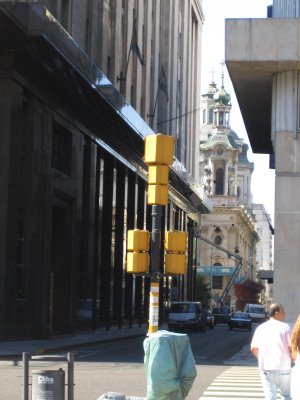
Looking south from the Plaza de Mayo to the Basilica of San Francisco
Here’s a closer view:

As you can see, the reconstruction on the 1911 Bavarian baroque façade kept us from going inside.
(Not really, we just weren’t there during the brief time it was open to the public).
We did get this picture of the towers:
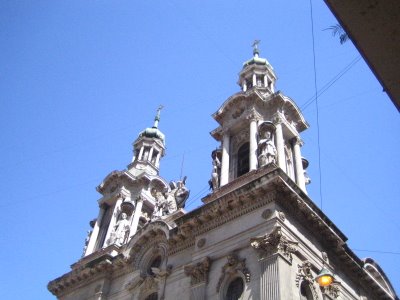
…and the exterior of the apse:

The neo-Italian Renaissance structure designed by a Jesuit architect dates from 1754.
By not going inside, we missed seeing second largest tapestry in the world honoring (who else) St. Francis; the work is by the Argentine artist Horacio Butler; it also contains one of the best archival libraries in the city.
----------------------------------------------------------------------
Typical bottom-of-the-blog stuff
Internet Explorer users, want to see more? Then download the Firefox browser by clicking here – these pages work better in it and its more secure.
Where are we now? Click here for an interactive map of Argentina.
Ignore these links unless you want to check other blogs on these topics:
Labels: vacation travel


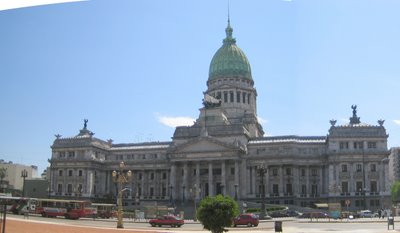
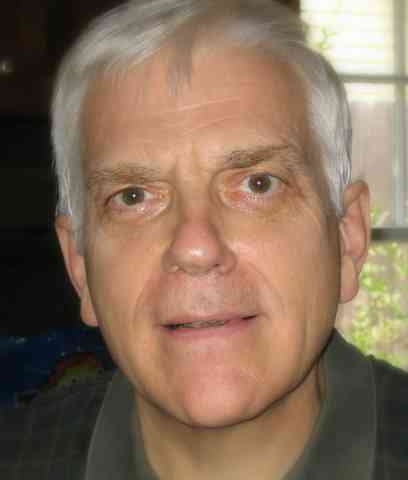

0 Comments:
Post a Comment
<< Home